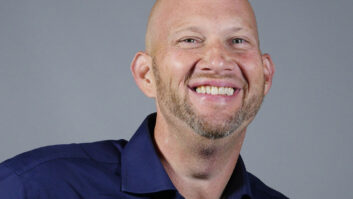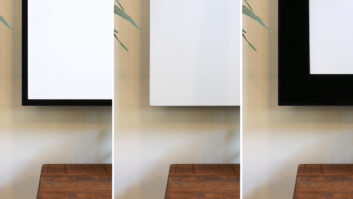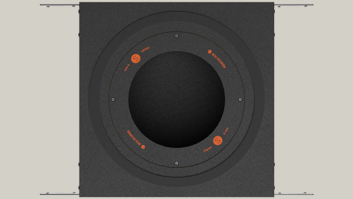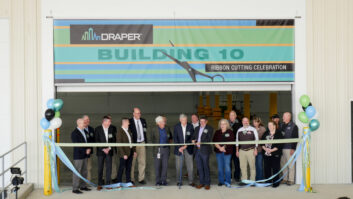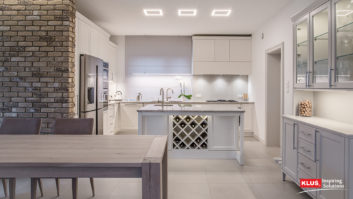It would be difficult to miss the sheer volume of new product announcements coming from Draper over the last six weeks. The 120-year-old projection screen, shades, and flat-panel display lifts manufacturer based in blink-and-you’ll-miss-it Spiceland, IN, has been on an R&D tear, and today it unveiled rebranding, a preview of its new website, and a forward-looking logo to show off to attendees of InfoComm and worldwide that the company is fully focused on the future.

Draper’s new logo
When I first moved back to Indiana in 2008, I went out of my way to visit local and regional companies. At the time, the Draper corporate team showed me Hoosier hospitality, and I left with fond memories of their operation. The company, however, generally kept to itself, humbly employing much of its town and winning dealer awards without much fanfare. But after a better-than-anticipated 2016, Draper not only chose to unveil a bunch of products, but invited a group of trade press for a look behind the curtain in Spiceland. I was there for a return visit, as was AV Nation’s Tim Albright (a fellow Midwesterner), but the rest of the invited group were in attendance for the first time. We were treated to dinner in downtown Indy before traveling an hour to the eastern part of the state the following morning for our tour.

Draper’s lobby, with a nod to its hometown
To kick things off, we were told about the company’s run of success, which also includes its little known (by our industry) dominance in the school gym basketball goal supports business. We learned that as the company, which boasts more than 650 employees, studied its success and looked forward to reinvesting in new products, they began to examine how to continue to provide customers with quality products and expert service. They sought outside help for a new perspective and listened to their customers.
Draper’s resulting rebranding marks what the company calls “a growing initiative to clarify the company’s mission, services and goals, simplify a business approach, and to refresh its relevancy to customers needs.” Draper’s rebranding, including many new aesthetic features, includes a fresh logo and tagline, a new look in signage and tradeshow presence, as well as a versatile website.
“Our rebranding is a significant step forward, while remaining true to the foundation laid nearly 120 years ago,” said Bob Mathes, director of audio-visual markets. “At Draper, we’re industry leaders and our fresh, modern approach expresses our approach to creating innovative solutions many of our customers know and love.”
Unbeknownst to most of us, two Swedish companies are now part of the Draper family: Smart Media Solutions (SMS), which specializes in brackets, digital signage, and outdoor casings and Evoko, which manufacturers meeting room manager products (a glowing red bezel lets an office’s employees know a board room is occupied and displays green when its open or available.)
We also learned from marketing manager Penny Sitler that in 2016, the company had its “biggest and best year” ever. “Now we get to celebrate our 115th anniversary and a new peak in our business, and we’re doing it by looking forward,” she said. “We’re freshening the brand identity to match the company we are today. We’re still investing in the future and investing in the company and community. Maintaining our integrity, improving our quality, and mostly, still innovating.”
The products that Draper makes are all assembled and operated before they are packed for shipping. Every “lot” of projection surfaces is passed through a rigorous series of tests for quality and consistency.
The company has invested heavily in the equipment its uses in its facility and has explored new manufacturing processes for efficiency, quality, and performance gains.

Laser cutting

Powdercoating

A quick look at the Tecvision surface lab

The Tecvision imaging lab

Draper’s custom printing room
Draper has been building custom products since 1902, but it also offers standard products to fill a lot of needs and challenges. The company has learned, however, that they’re best suited to finding custom-tailored shades and screens solutions to meet specific customer needs.
The Draper family of companies includes SMS, Evoko meeting room accessories, Draper Canadian (its Canadian distribution arm), Draper Group Ltd., (its UK sales and distribution center), and Draper AV in Hogstadt Sweden. Beyond that core family, Draper is also creating partnerships, for OEM manufacturing. Kevin Barlow is charged with developing and maintaining these private and public partnerships.

Draper has moved to large custom screen needs of customers.
On the tour, production manager Harold Seib showed off the plant’s custom fabrication capabilities for its screens lines. The company cuts and forms sheet metal and processes aluminum. Plastics are brought in from outside. A 35-foot long oven powder coats aluminum extrusions for shades and screens. Five standard colors are available for shades. On the screens side, most are black and white, but then Draper also does a whole array of custom colors for a fascia, headboxes, or end caps.
One of the company’s most impressive one-off custom projects being staged in the facility while we were there was a set of giant, automated louvers for the Canadian Parliament building. The blinds were designed in Spiceland, the aluminum was manufactured in Poland, the project was prototyped in Germany, and it was to be installed in Canada… all over three years.

Giant louvers for the Canadian Parliament
As we looked at punch presses, screen material testing labs, a digital screen printing room, and even a quick look into how Draper manufactures its proprietary Tecvision surface, Mathes told us that back in 2000 Draper opened a plant in China, with the thought that they had to compete with the onslaught of Asian manufacturing. “We were desperate to figure out how we could lower our costs,” he said. “We were sourcing products like crazy—components. We didn’t want to necessarily bring those products into the States at that point; that was more to compete through the rest of the world.”
Draper closed that plant in China after five years, realizing that it was more difficult to conduct business there than they thought. “That’s when we came to the realization that you can’t compete based on commodities,” Mathes said. “You have to add some value for the customer. I think that’s when things really began to click that we needed to figure out how to be different.”
The first application of that philosophy, Mathes said, started with custom solar control solutions and followed with projection screens. “That’s really the launching pad about how we can actually provide a total solution or a joint solution with outside companies to meet what the customer needs,” he explained. “And, at that point, it’s not about price. It’s about how you work, are you easy to work with, do you have quality products, do you have the resources.”
As a result, the company now employs 18 engineers, which is double the amount they had only about seven years ago. Those engineers allow Draper to design products in-house, based on what the customer is asking for.
Mathes acknowledged that since 2008, the projection screen market for the company has been declining, due to increased competition, competition from flat panels in boardrooms and smart board in schools. But even though its screen business may be “stagnant or somewhat declining,” Mathes said, the opportunity for “somewhat larger stuff” is still there.
“As a company, we’re unique in that we can leverage the engineering resources that are in solar control, that are in shades, that are in screens, that are in gym equipment… All of those resources come together and makes us a much larger company than anyone has ever thought of us in the past,” Mathes said. “So we look at where the needs are, and you get into staging applications, simulation business—all types of corporate use. There is still a need for screen technology, because it is the most appropriate solution.”
That being said, Mathes sees a “projector renaissance” going on in the InfoComm channel. “But, it’s all in the high end, above 100 inches (wide),” he said. “All projection companies are investing in new technologies. Nobody is throwing in the towel.”
Barlow added that the messaging that customers saw from Draper at InfoComm this week will be a lot different from what they will see at InfoComm in 2018. “There’s a lot going on behind the scenes that the company is not ready to put out there yet,” he said. “This is like an appetizer. There’s much more to come.”

